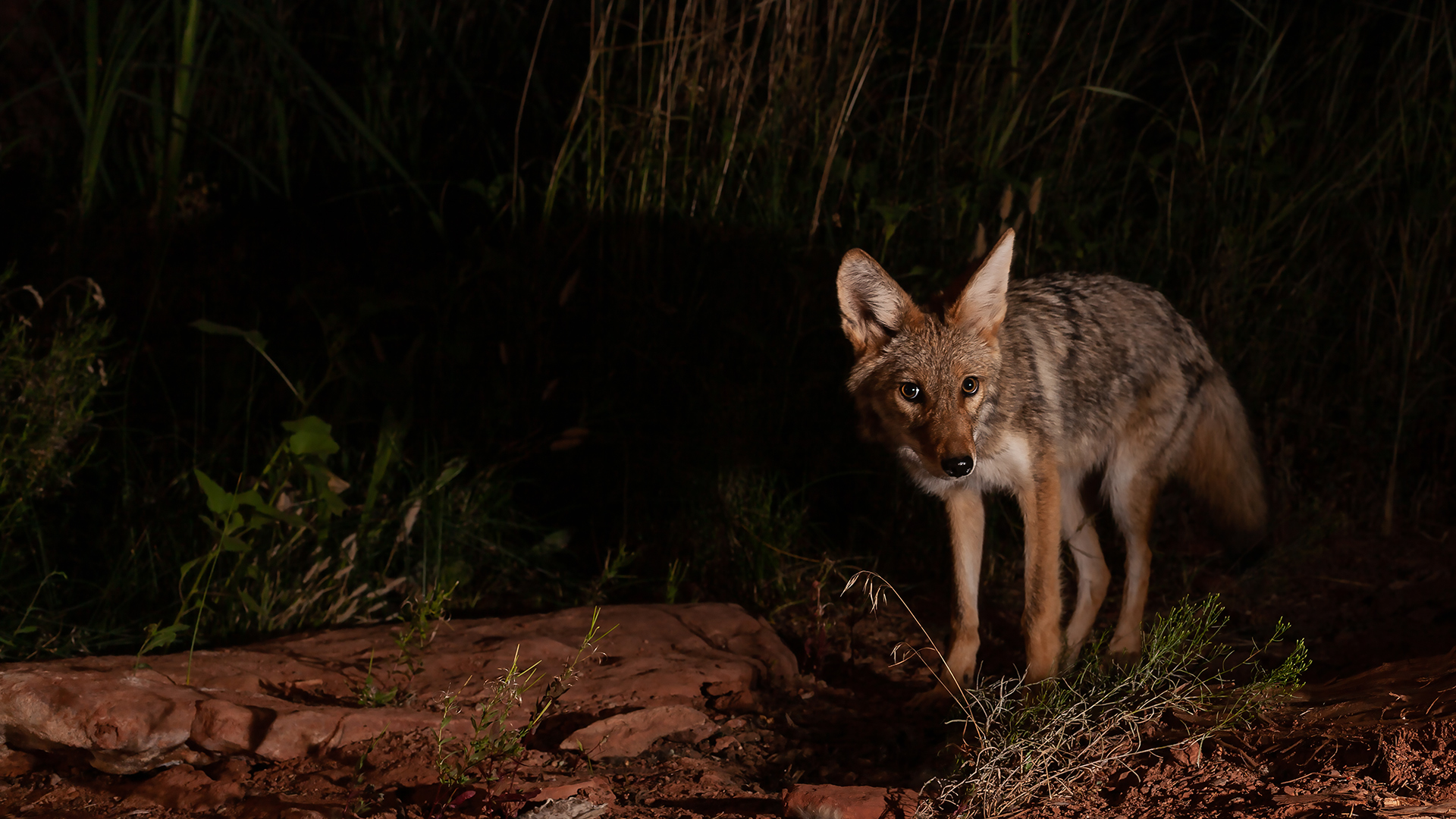
The Coyote’s Journey
“The coyote…has as much right to be here as we do,” environmental activist Edward Abbey once wrote. These days, he wouldn’t get much agreement.
Most nights before bed, I stand on the deck of my cottage, giving thanks for the North Carolina barrier island I call home. On this winter evening, stars sequin a velvet sky and a moon just past full illuminates a dusty one-lane gravel road that runs between me and the sound. From a nearby live oak, the piercing screech of a barred owl rends the silence. A second owl answers from a cedar tree. I shiver in awe, listening as they call and respond for more than an hour across the maritime forest.
Most nights before bed, I stand on the deck of my cottage, giving thanks for the North Carolina barrier island I call home. On this winter evening, stars sequin a velvet sky and a moon just past full illuminates a dusty one-lane gravel road that runs between me and the sound. From a nearby live oak, the piercing screech of a barred owl rends the silence. A second owl answers from a cedar tree. I shiver in awe, listening as they call and respond for more than an hour across the maritime forest.
As I turn to go inside, a shadow ripples. I freeze, hand on the door latch. A coyote ambles along the road.
The coyote stops, her bushy tail down between her hind legs, her coat a patchwork of brown and gray, thickened for winter. She stares at me. Her molten amber eyes glow in the moonlight, boring into me. I stare back, hoping she senses softness and kinship. She saunters off into the darkness.
The next morning, I call my friend Ann, who lives a few houses away. She too saw a coyote last night, possibly the same one.
“My next-door neighbor John says he’s going to shoot the next one he sees,” Ann tells me.
It is coyote mating season, which will continue until March is over. It’s also real estate development season, which will never end.
Development across the sound, on the mainland, consumes habitat and pushes coyotes, deer, foxes, bears, snakes, turtles, opossums, raccoons, rats, and more to swim across the sound, seeking food and shelter. Now, as construction also increases on the island, these animals are being forced into smaller areas.
The once-isolated island where I live, not long ago occupied only by a few families year-round, is changing quickly. It once attracted just regional tourists in summer and fisherfolk in autumn. It now attracts people from all over the country seeking coastal property. Many do not understand, or care about, the risk of building so close to the sea. There is little regard for natural animal habitats.
Conservation laws—except for a few, including dune preservation and federally mandated maritime laws—are nearly non-existent. I hate survey stakes fluttering with pink ribbons.
Excited by the exorbitant amount buyers will pay, landowners sell, and zoning laws and infrastructure either cannot, or do not, keep pace. Conservation laws—except for a few, including dune preservation and federally mandated maritime laws—are nearly non-existent.
I hate survey stakes fluttering with pink ribbons.
Developers covet the maritime forest surrounding older cottages. I awaken many mornings to the sound of bulldozers ripping trees from the forest and crushing nearby houses. Backhoes load the carnage into dump trucks, leaving naked land, which is unable to absorb rainwater run-off in the same amount as it did when covered in old growth trees.
The interior walls of these old houses are tongue-and-groove, fashioned from knotty pine. Cedar shakes cover the outside walls. Their floors are solid oak. They have withstood some of the coast’s worst hurricanes. I treasure the way they seem to breathe with the tides, the way they smell of the marsh, the stories they could tell.
The current real estate trend is to destroy these vintage cottages and erect in their place three-story mansions with five-plus bedrooms, elevators, and swimming pools. New construction makes the land more vulnerable. Less than a mile from my narrow gravel road, developers are clearing a swath of twenty-five acres to build houses and apartment buildings. Some oaks in that maritime forest are nearly 200 years old.
The forest’s elaborate root system plays a crucial role in the island’s fragile ecosystem. These roots hold the island in place. As the forest is ripped away by either natural disasters or cleared for construction, the island becomes more susceptible to flooding from hurricanes, not just along the shoreline, but in the island’s interior as well. Landscapers replace native oaks, cedars, myrtles, and a network of vines with non-native trees, many of which have shallow root systems.
Southeast coastal barrier islands move by natural design. The island on which I live shifts as prevailing winds, hurricanes, and the traveling ocean floor force sand to be dislodged from the northern end and deposited on the southern. The island also moves from east to west because of erosion or the catastrophic slicing away of dunes during storms. Oceanfront property coveted for building today may be washed away by tomorrow’s hurricane.
The only protection the island has against this migration, this naturally occurring phenomenon, is a network of deep-rooted vines, shrubs, and trees. Here is a partial list of wild native plants that grow on local dunes: yaupon, wax myrtle, wild grapes, catbrier, pennywort, sea oats, bitter panicum, sea rocket, passionflower, gaillardia flowers (called by several names), sea beach evening primrose, silver leaf croton, sand bean, goldenrod, butterfly pea, camphorweed, Virginia creeper, marsh elder, and red cedar.
Nestled among this dune vegetation, coyotes live and raise their pups.
Why have residents singled out coyotes as the worst of the invasive animals that have fled to the island from encroaching development? Perhaps they harbor an atavistic fear from prehistoric times when humans and canids (wolves, coyotes, foxes, and their relatives) fought over possession of the same denning complexes. Perhaps the stories of coyotes killing pets frighten them. Perhaps they see a coyote’s life as insignificant, less valuable than their own.
That night, on the deck, I’m sending silent messages to the coyote, begging her not to appear. The tide is low, and I inhale the fecund fragrance of the marsh as if it were an elegant perfume.
Wildlife experts suggest humans and coyotes might coexist, with minor changes in human behavior. To prevent attracting coyotes, homeowners could keep areas around homes free from garbage, pet food, water, and dead animals. They could keep pets indoors or well attended when outside.
Some people, however, demand total extermination, and laws are not on the coyote’s side. In some states, coyotes can be hunted on public property with guns or bows and arrows year-round, at any hour, with the aid of lights and electric callers. Coyotes may be shot on private property if a landowner claims they are causing damage.
That night, on the deck, I’m sending silent messages to the coyote, begging her not to appear. The tide is low, and I inhale the fecund fragrance of the marsh as if it were an elegant perfume.
In the darkness, the island lies quiet. The dunes mute the sound of waves breaking in the ocean. The usual small noises—mice scurrying through fallen leaves, bullfrogs croaking, a great blue heron squawking on a neighbor’s dock—are silent.
As she did the night before, the coyote materializes out of the shadows. She turns to face me for a moment, then saunters on. The coyote passes two more houses, then Ann’s house. She freezes. So do I.
A shot blasts and gravel sprays. I scream, “No!”
The shot misses, and the coyote races out of sight.
“Why the hell did you scare him off?” John hollers.
I’m silent.
“I’ll get him,” John calls. “Just you wait.”
So we wait, the coyote and I.
About the author
Deb Bowen lives and writes on a North Carolina barrier island. She is the co-author of "A Good Friend for Bad Times: Helping Others Through Grief." She has a novel and several other works in progress.






I am so very honored to have this work published in Salvation South. I am grateful for your support of our southern ecosystems!
Thank you Deb Bowen for another beautifully written story and for taking us to a wonderful place. This one forces us to consider who the predators are.
Thank you so much for your kind words Nelson. Indeed, who is the predator? How might we consider ways to live peacefully with all beings, and honor the earth? Best to you, Deb
This is a beautiful essay with a killer last line. Thank you again, SS. We all have a great friend in Deb Bowen.
Thank you so much Janisse. Your encouragement and edits were invaluable and I’m grateful. We all have a great friend in Janisse Ray!
This is both devastating and beautifully rendered, Deb. Thank you for sharing another poignant offering on our troubled world. I so admire how you speak from and for your threatened homeplace.